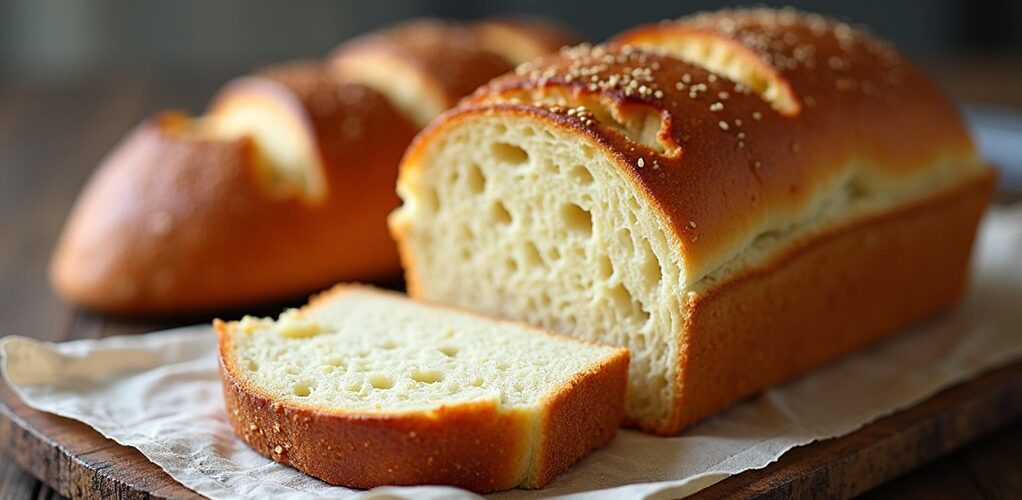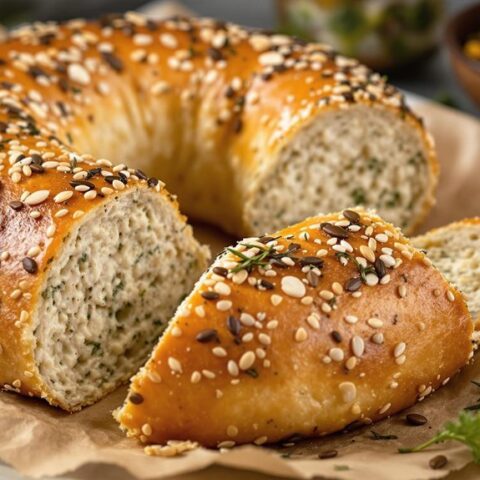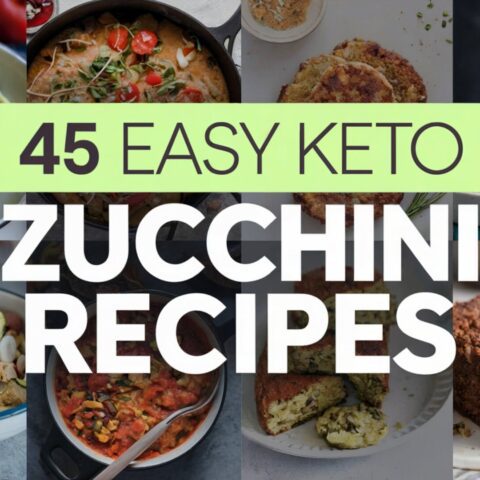
Keto bread's low-carb status depends entirely on its ingredients. While traditional bread contains 15-20 grams of carbohydrates per slice, authentic keto bread should have under 5 grams of total carbs. Consumers must carefully examine labels for hidden carb sources like oat flour, modified starches, and maltodextrin. Quality keto bread primarily uses almond flour, coconut flour, or psyllium husk as base ingredients. Understanding the full ingredient list reveals whether a product truly supports ketosis goals.
Key Takeaways
- True keto bread must contain less than 5 grams of total carbohydrates per slice to be considered genuinely low-carb.
- Main ingredients should be almond flour, coconut flour, or psyllium husk rather than wheat flour or grain-based ingredients.
- Check for hidden carbs in ingredients like maltodextrin, modified starches, and natural sweeteners that can affect ketosis.
- Calculate net carbs by subtracting fiber content from total carbohydrates to determine if the bread fits keto requirements.
- Verify that binding agents like eggs, xanthan gum, and psyllium husk are used instead of high-carb alternatives.
What Makes Traditional Bread High in Carbs
Traditional bread stands as one of the most carbohydrate-rich foods in the modern diet, primarily due to its fundamental ingredient: wheat flour. The starch-rich composition of wheat flour contributes considerably to the bread's high carb content, typically delivering 15-20 grams of carbohydrates per slice. The carbohydrate load in traditional bread extends beyond the wheat flour base, as many recipes incorporate added sugars and other high-carb ingredients that further raise the total carbohydrate content. Even varieties made with whole grains, while offering more fiber, maintain substantial carb levels. The refined grains commonly used in bread production lack sufficient fiber to offset their carbohydrate impact, making traditional bread a concentrated source of carbs that can challenge those seeking to reduce their carbohydrate intake. It's important to note that white bread, often made with refined carbohydrates, converts swiftly to glucose, disrupting ketosis.
Understanding Keto-Friendly Ingredients
Reading nutrition labels on keto bread products requires careful attention to distinguish between total carbohydrates and net carbs, which account for fiber content and sugar alcohols. Hidden carbohydrate sources can appear under various names on ingredient lists, including modified starches, maltodextrin, and certain thickening agents that might compromise ketogenic dietary goals. Consumers should focus on products containing proven keto-friendly ingredients like almond flour, coconut flour, and psyllium husk, while being particularly vigilant about ingredients listed within the first few positions, as these represent the largest proportions in the product. It is crucial to select sweeteners with a low glycemic index to maintain stable blood sugar levels and support ketosis.
Reading Nutrition Labels Carefully
While many breads marketed as keto-friendly claim to be low in carbohydrates, understanding nutrition labels is essential for maintaining a successful ketogenic diet.
When evaluating keto bread options, consumers should first check that total carbohydrates remain under 5 grams per slice, with net carbs ideally falling between 2-5 grams. Products made primarily with almond flour or other low-carb alternatives typically offer better options for maintaining ketosis.
The fiber content, often enhanced by ingredients like psyllium husk or ground flaxseed, should be considered when calculating net carbs. Careful attention must be paid to hidden sugars and high-carb additives in the ingredient list, as these can greatly impact the bread's true carbohydrate content and potentially disrupt ketosis.
Identifying Hidden Carb Sources
Understanding hidden carb sources in keto bread requires careful scrutiny of ingredient lists beyond the basic nutrition facts. When examining keto bread ingredients, consumers should be vigilant about identifying elements that could inadvertently increase net carbs and potentially disrupt ketosis.
- Oat flour and other grain-based ingredients may be included in small amounts but can greatly impact carb content.
- Modified starches and thickeners often appear under various names but contribute to total carbohydrates.
- Natural sweeteners like honey, maple syrup, or dates might be used as binding agents.
- Maltodextrin and other processed additives can increase blood sugar levels despite being labeled as "low carb."
To maintain a true low-carb profile, keto bread should primarily contain ingredients like almond flour, coconut flour, psyllium husk, and approved sugar alternatives, while avoiding hidden carbohydrate sources that could compromise ketogenic goals.
Common Red Flags in Keto Bread Labels
When examining keto bread labels, consumers should watch for hidden sugars and starches that often appear under various names, including maltodextrin, modified food starch, or natural sweeteners. Marketing claims such as "low carb" or "keto-friendly" may not tell the complete story, as manufacturers can manipulate serving sizes or use questionable fiber sources to reduce net carb calculations. Accurate net carb calculations require careful scrutiny of the nutrition panel, particularly the relationship between total carbohydrates, fiber content, and sugar alcohols, which some manufacturers may present in misleading ways. Recognizing serving sizes ensures accurate nutrient tracking, as many packaged foods contain multiple servings.
Hidden Sugars and Starches
Guiding through keto bread labels requires careful attention to detect hidden sugars and starches that could derail ketogenic dietary goals. Many manufacturers market their products as keto-friendly while incorporating ingredients that can impact net carbs.
Traditional wheat alternatives like tapioca flour and potato starch often appear alongside sugar alcohols and natural flavors, potentially compromising low carb objectives.
- Sugar alcohols like erythritol may be labeled as zero-calorie but can affect blood sugar
- Products marketed as "keto-friendly" might contain high-carb flour alternatives
- Natural flavors can mask added sugars that contribute to total carbohydrate content
- Almond flour and coconut flour remain the most reliable low-carb base ingredients for authentic keto bread options
Misleading Marketing Claims
Numerous marketing claims on keto bread packaging can mislead consumers about the true carbohydrate content and nutritional value of these products. Terms like "net carbs" often obscure the actual carbohydrate count, particularly when manufacturers use creative calculations that exclude fiber and sugar alcohols.
Manufacturers frequently employ deceptive marketing strategies by highlighting low carb claims while concealing hidden carbs in the ingredient list. Common tactics include using alternative names for high-carb ingredients or incorporating fillers that contribute to the total carbohydrate content.
To avoid these misleading marketing practices, consumers should carefully examine product labels, scrutinize ingredient lists for concealed starches or sugars, and verify how manufacturers calculate their carbohydrate claims. Understanding these marketing tactics helps shoppers make more informed decisions about their keto bread purchases.
Net Carb Calculation Issues
Understanding net carb calculations on keto bread labels presents considerable challenges for consumers trying to maintain a ketogenic lifestyle. When evaluating whether a bread is truly low in carbs, consumers must carefully subtract fiber and sugar alcohols from total carbohydrates to determine accurate net carbs per serving. Many manufacturers' claims require thorough verification through ingredient analysis.
- Check serving sizes carefully, as they greatly impact daily carb intake calculations
- Verify the presence of high in fiber ingredients like psyllium husk
- Look for hidden added sugars or conventional flours that increase carb content
- Calculate net carbs independently rather than relying on manufacturer claims
Proper label reading guarantees accurate tracking of carbohydrate intake, helping maintain ketosis while enjoying keto-friendly bread alternatives without compromising dietary goals.
Calculating Net Carbs in Keto Bread
Determining the true carbohydrate content of keto bread requires a simple yet vital calculation of net carbs. To find net carbs, consumers must subtract the dietary fiber from the total carbohydrates listed on the product's nutritional label. For example, if a slice of keto bread contains 4 grams of total carbohydrates and 2 grams of fiber, the net carb count would be 2 grams.
Most keto bread makers use low carb ingredients like almond flour, coconut flour, and psyllium husk, which contribute minimal net carbs while providing beneficial fiber. Almond flour is a popular choice due to its low net carb content and rich supply of healthy fats and vitamin E, making it an excellent ingredient for keto baking.
When evaluating keto bread options, it's important to examine the ingredient list for hidden carbohydrate sources, such as wheat flour or added sugars, which could compromise the bread's low-carb status and affect ketogenic dietary goals.
Essential Keto Bread Components
Keto bread relies on specialized low-carb flours like almond and coconut flour as primary ingredients, serving as alternatives to traditional wheat flour while maintaining structural integrity. Eggs, psyllium husk, and xanthan gum act as essential binding agents, providing the protein structure and cohesiveness typically supplied by gluten in conventional bread. The addition of baking powder, baking soda, and fiber-rich ingredients like ground flaxseed helps create proper texture and rise while contributing beneficial dietary fiber to the final product. Low-carb keto bread typically contains 2-5 grams of net carbs per slice, supporting the maintenance of ketosis effectively.
Primary Flours and Alternatives
The foundation of any successful keto bread lies in selecting the right low-carbohydrate flours and alternatives to replace traditional wheat flour. Almond flour and coconut flour stand out as primary keto-friendly flours, with almond flour containing just 2-3 grams of net carbs per tablespoon.
Coconut flour's high fiber content helps offset its 6 grams of net carbs, while psyllium husk powder serves as an essential binding agent with minimal carb impact.
- Almond flour provides a nutty flavor and maintains moisture in keto bread
- Coconut flour's high absorbency requires careful liquid ratio adjustment
- Psyllium husk powder creates an authentic bread-like texture
- Alternative options include ground flaxseed and sunflower seed flour for variety
These low-carb ingredients work together to create bread that fits within ketogenic dietary guidelines while maintaining familiar textures and tastes.
Binding Agents and Proteins
Successful creation of keto bread depends heavily on the careful selection and combination of binding agents and proteins that work together to replicate the structure-building properties of gluten.
Common binding agents like psyllium husk and ground flaxseed provide essential structure while maintaining the low carb requirements of keto bread. These ingredients work synergistically with eggs, which serve as both a protein source and binding agent, contributing 3-5 grams of protein per slice.
Gluten flour enhances the bread's texture and elasticity, while inulin serves multiple functions as a binding agent and natural sweetener.
Together, these components create a cohesive dough that rises properly and maintains its structure, resulting in a bread-like consistency that satisfies both nutritional and textural requirements of keto-friendly baking.
Leavening and Fiber Components
Beyond binding agents, leavening components play a fundamental role in creating light, airy keto bread that closely mimics traditional wheat-based varieties.
When combined with fiber components like psyllium husk and ground flaxseed, leavening agents such as baking powder help achieve the desired texture while maintaining low carb content. The strategic use of almond flour further guarantees minimal carbohydrate impact, typically contributing only 2-3 grams of net carbs per tablespoon.
- Baking soda and baking powder create the essential rise and fluffiness in keto bread
- Psyllium husk and ground flaxseed enhance texture while adding beneficial fiber
- Inulin serves dual purposes as a prebiotic fiber and natural yeast activator
- The combination of these ingredients maintains carb content below 5 grams per slice
Comparing Store-Bought Keto Bread Options
When steering through the expanding market of store-bought keto bread options, consumers can find numerous varieties that contain considerably fewer carbohydrates than traditional bread, typically less than 5 grams per slice. These low-carb alternatives often utilize ingredients such as almond flour, coconut flour, and psyllium husk instead of conventional wheat flour. While many store-bought keto bread products are gluten-free and maintain low carbohydrate content, careful label reading remains crucial. Some brands may incorporate hidden sugars or starches that can increase the overall carb count. Consumers should thoroughly examine nutritional information and ingredient lists to confirm their chosen keto bread aligns with their dietary requirements, particularly when seeking options that maintain authentic low-carb profiles suitable for ketogenic eating plans. It's essential to ensure that keto bread includes high-fat dairy options such as full-fat cheese to enhance flavor and satiety.
Hidden Carbs to Watch Out For
Although keto bread products may appear low in carbohydrates at first glance, consumers should remain vigilant about hidden sources of carbs that can potentially disrupt ketosis.
When examining ingredients lists, it's essential to identify common additives and components that may contribute unexpected carbohydrates to supposedly low carb products.
- Sugar alcohols like erythritol can affect blood sugar levels differently in each individual
- Fiber additives and inulin may add minimal but cumulative carbohydrate content
- Serving sizes on packaging often underrepresent typical consumption portions
- Some specialty flours and binding agents contribute hidden carbs despite keto-friendly claims
Understanding these potential sources of hidden carbs helps consumers make informed decisions about keto bread products, ensuring they align with their dietary goals and maintain ketosis effectively. Additionally, some low-carb breads have been reported to cause unexpected blood sugar spikes, emphasizing the need for consumers to monitor their individual responses carefully.
Best Low-Carb Flour Alternatives
Selecting the right low-carb flour alternatives requires careful consideration of their unique properties and carbohydrate content to achieve successful keto bread recipes. Proper measurement techniques become essential when working with alternative flours, as they often behave differently from traditional wheat flour regarding moisture absorption and binding capabilities. Understanding the correct ratios and substitution methods for ingredients like almond flour, coconut flour, and psyllium husk powder guarantees consistent results in keto bread making. Incorporating high-fiber options like these can aid digestion and promote satiety, similar to the benefits seen with low-carb pasta alternatives.
Choosing Flour Substitutes Wisely
Making the switch to low-carb flour alternatives represents an important step in creating authentic keto bread that maintains the desired texture while keeping carbohydrates minimal.
When selecting flour substitutes, understanding their unique properties helps achieve ideal results in keto baking. Almond flour and ground flaxseed work exceptionally well together, providing structure and nutritional benefits while keeping net carbs low.
- Almond flour offers versatility with only 2 grams of net carbs per tablespoon
- Coconut flour requires additional liquid due to its high absorption properties
- Psyllium husk powder acts as a vital binding agent with zero net carbs
- Sunflower seed flour provides a mild flavor profile suitable for various recipes
These alternatives guarantee bakers can create delicious low-carb bread while adhering to ketogenic dietary requirements.
Measuring Alternative Flours Correctly
Precise measurement of alternative flours stands as a fundamental aspect of successful keto bread preparation. When measuring alternative flours, using a kitchen scale guarantees accuracy, as each low-carb flour option possesses distinct density characteristics. Understanding proper conversion ratios becomes essential, particularly when working with coconut flour, which requires only one-quarter the amount of almond flour in recipes.
| Flour Type | Net Carbs per Serving | Measurement Notes |
|---|---|---|
| Almond Flour | 6g per 1/4 cup | Direct 1:1 substitute |
| Coconut Flour | 4g per 1/4 cup | Use 1/4 amount + extra liquid |
| Psyllium Husk | <1g per tbsp | Add gradually for texture |
| Flaxseed Meal | 2g per 2 tbsp | Partial flour replacement |
The Role of Fiber in Keto Bread
While conventional bread can derail a ketogenic diet, the strategic incorporation of fiber in keto bread serves multiple essential functions for those following a low-carb lifestyle.
Fiber plays a vital role in reducing the net carbohydrate count by offsetting total carbs, helping individuals stay within their daily limit of 50 grams or less. High-fiber ingredients like psyllium husk and ground flaxseed enhance both the bread's texture and nutritional profile.
- Contributes to digestive health with 1-5 grams of fiber per slice
- Helps maintain stable blood sugar levels
- Promotes feelings of fullness and satiety
- Improves overall nutrient absorption and bowel health
These fiber-rich components make keto bread a practical option for maintaining ketosis while satisfying bread cravings. Additionally, following the ketogenic diet can lead to improved insulin sensitivity, which is essential for managing type 2 diabetes.
Reading Nutrition Labels Effectively
Successfully maneuvering nutrition labels on keto bread requires understanding key components that determine its compatibility with a ketogenic diet.
When examining labels, start by locating the total carbohydrates, which should ideally be under 5 grams per slice for true keto compliance. Calculate net carbs by subtracting fiber content from total carbohydrates, as this figure more accurately reflects the bread's impact on ketosis.
The ingredients list demands equal attention, as authentic low carb bread should feature alternatives like almond or coconut flour rather than wheat-based ingredients.
Scrutinize the sweetener options, ensuring they're keto-friendly alternatives such as erythritol or stevia. Additionally, verify that the product contains adequate fat content, typically 70-80% of total calories, to support ketogenic dietary requirements.
Including non-starchy vegetables in your diet can further aid in maintaining low-carb goals, as they are nutrient-dense and support overall health.
Impact of Different Sweeteners
Different sweeteners used in keto bread can markedly impact both its carbohydrate content and metabolic effects. When selecting keto bread, understanding the sweeteners used is essential for maintaining low carb goals.
Sugar alcohols like erythritol and xylitol provide sweetness while minimizing blood sugar impact, making them popular choices in keto bread recipes. Natural alternatives such as stevia and monk fruit extract offer zero-calorie sweetening options without affecting ketosis.
- Erythritol and xylitol contain fewer calories than traditional sugar while maintaining sweetness
- Stevia provides sweetness without adding carbohydrates or calories
- Monk fruit extract is a natural zero-calorie option that doesn't affect blood sugar
- Some sweeteners may contain hidden carbs, requiring careful label reading
Storing Keto Bread Properly
Proper storage practices greatly impact the quality and longevity of keto bread, much like choosing the right sweeteners affects its carbohydrate content.
To maintain the integrity of its low carb ingredients, keto bread requires specific storage conditions to prevent premature spoilage.
Preserving keto bread's quality demands careful attention to storage methods, ensuring its specialized ingredients remain fresh and effective.
Refrigeration is essential for preserving keto bread, with covered storage extending freshness up to two weeks. For longer-term storage, freezing offers a practical solution, allowing the bread to remain viable for up to six months when properly sealed in freezer bags.
To maximize convenience, consider slicing the bread before freezing, enabling easy access to individual portions. When retrieving frozen slices, allow them to thaw overnight in the refrigerator.
Room temperature storage should be avoided, as the delicate ingredients in keto bread make it particularly susceptible to spoilage.
Measuring Portion Sizes Accurately
Maintaining precise portion sizes stands as a cornerstone of successful keto bread consumption, particularly when tracking daily carbohydrate intake for ketosis. A kitchen scale provides the most accurate measurements for ingredients, especially when weighing flours and dry components.
Understanding that typical keto bread contains 1-2 grams of net carbs per slice helps individuals stay within their daily limits.
- Use a digital kitchen scale for precise flour measurements
- Employ measuring cups and spoons for consistent portion control
- Document serving sizes in a nutrition tracking app
- Monitor slice thickness to maintain standard portions
For best results, combine multiple measuring methods to guarantee accuracy.
This systematic approach to portion control allows for better management of carbohydrate intake while enjoying keto bread as part of a balanced ketogenic diet.
Signs of Quality Keto Bread Products
Identifying genuine keto bread products requires careful attention to specific quality markers that distinguish them from conventional alternatives. When evaluating keto bread options, consumers should examine the nutritional label and ingredient list for key indicators of quality.
| Quality Marker | What to Look For |
|---|---|
| Net Carbs | Less than 5g per slice |
| Floor Base | Almond flour or coconut flour |
| Fats | High-quality oils or butter |
| Sugar Content | Sugar substitutes only |
| Fiber Source | Psyllium husk or similar |
Quality low carb bread products prioritize wholesome ingredients while maintaining ketogenic standards. The presence of almond flour and natural fiber sources, combined with the absence of added sugars, indicates a product that genuinely supports a ketogenic lifestyle. Careful examination of these elements guarantees consumers select bread products that align with their dietary goals.
Frequently Asked Questions
Is Keto Bread Actually Low-Carb?
Keto bread ingredients create genuine low-carb alternatives, containing under 5g carbs per slice versus regular bread's 15-20g. High fiber content and alternative flours maintain nutritional comparisons despite taste differences.
What Are the Disadvantages of Keto Bread?
Keto bread ingredients can be expensive and hard to find. The nutritional content remains calorie-dense, potential allergens like eggs pose risks, and high fiber content may cause digestive issues for some consumers.
What Are the Warning Warnings on Keto Culture Bread?
Keto bread ingredients may contain artificial sweeteners and allergens. Labels warn about gluten free options, high fiber content, and nutritional value variations. Consumers should check ingredients for hidden carbs and allergens.
Is Aldi Keto Bread Really Carb Free?
Aldi bread marketed as keto contains minimal but not zero carbs. The nutritional facts indicate fewer than 5g net carbs per slice, using keto ingredients to provide health benefits while maintaining low carb content.
Conclusion
Making informed choices about keto bread requires careful label reading and ingredient awareness. While many products claim to be keto-friendly, consumers should focus on net carb calculations, examine sweetener types, and verify the presence of low-carb flour alternatives. Quality keto bread should contain primarily almond or coconut flour, natural ingredients, and minimal additives. By understanding these components and proper portion sizes, individuals can maintain ketosis while enjoying bread alternatives.










No Comments